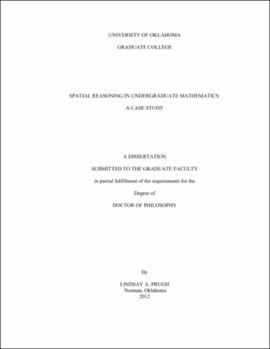| dc.description.abstract | The need for spatial thinkers is evident in the growing concerns regarding the performance of U.S. students in mathematics and the lack of interest in spatially-driven fields such as science, technology, engineering, and mathematics. Although the focus on spatial research has fluctuated over decades of educational reform, a platform has been established through the support of national organizations such as the National Research Council (2006) and the National Council of Teachers of Mathematics (NCTM, 2000). Even with such powerful recognition, purposeful cultivation of spatial thinking is commonly overshadowed by other factors in the mathematics classroom, especially at the undergraduate level. According to NCTM, problem solving is an integral part of all mathematics learning. Further, research has linked spatial thinking to problem solving, indicating that spatial thinking is a necessary skill for success in solving problems in mathematics. This embedded case study examined how the inclusion of spatial tasks influenced problem-solving performance, spatial thinking ability, and beliefs of undergraduate mathematics students. Data were collected through quantitative instruments, such as the Purdue Spatial Visualization Test, the Mathematical Processing Instrument, and the Spatial Thinking Attitude Survey, as well as qualitative instruments, such as student-written journal responses, focus group interviews, and observations. The findings of this study suggest the inclusion of spatial thinking tasks has an influence on students' spatial visualization ability, problem-solving strategies, and beliefs about the relevance of spatial thinking. As long as problem solving remains a goal for learners of mathematics, spatial thinking must be fostered in students of mathematics as well as those who desire to teach mathematics. | |
